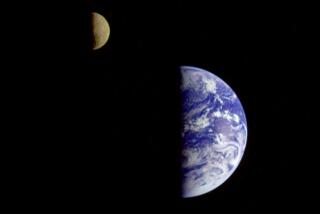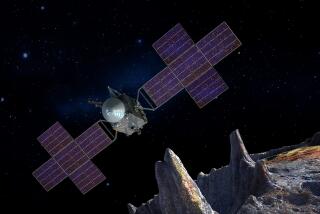Scientists Get Close Look at Asteroid : Astronomy: Radar captures detailed pictures of Toutatis as it zooms by Earth. JPL researchers say similar objects may have wiped out dinosaurs.
- Share via
Astronomers in Pasadena on Sunday said new radar pictures of an asteroid that flew close to Earth have given them the best look yet at the kind of object that may have wiped out the dinosaurs and someday could threaten humanity.
“This is our first clear look at one of the many thousands of asteroids whose orbits can intersect Earth’s orbit,” said Steven Ostro, a senior researcher at the National Aeronautics and Space Administration’s Jet Propulsion Laboratory. “The planet exists in a swarm of asteroids.”
Ostro said the pictures of the asteroid Toutatis are 100 times more detailed than previous images of an “Earth-approaching” or “near-Earth” asteroid, the type that on rare occasions hits the planet with the power of thousands of nuclear warheads.
NASA bounced radar waves off Toutatis last month using a 230-foot-wide antenna dish at a tracking station in California’s Mojave Desert.
The radar echoes were captured by a 112-foot-wide antenna to make pictures of Toutatis on Dec. 8, 9, 10 and 13.
In 1991, the Jupiter-bound Galileo spacecraft became the first to visit an asteroid, taking close-up photographs of Gaspra. Unlike Toutatis, Gaspra is in the main asteroid belt between Mars and Jupiter.
The images show Toutatis is composed of two chunks of rock, probably held in contact by gravity, Ostro said. One chunk has an average width of about 2.5 miles; the other is about 1.6 miles wide, he said.
Scientists had thought Toutatis was only one to two miles wide until they took pictures when it whizzed within 2.2 million miles of Earth--a close call in astronomical terms.
“It’s the most irregularly shaped object we’ve yet seen in the solar system,” Ostro said, describing the asteroid as “two highly irregular, cratered, battered, jagged objects” that have been smacked repeatedly by other asteroids.
Scientists increasingly believe a six- to nine-mile wide asteroid hit Mexico’s Yucatan Peninsula 65 million years ago, kicking up enough dust to darken the skies, chill the climate, destroy plants and kill dinosaurs and most other species.
Despite erosion, scores of other impact craters have been found on Earth. In 1908, an incoming asteroid blew up over Siberia, flattening nearly 1,000 square miles of uninhabited forest.
Last year, a NASA report estimated a 1-in-10,000 chance during “our lifetime” that an asteroid measuring at least one-third of a mile wide will hit Earth, destroy food crops and “possibly end civilization as we know it.”
If an asteroid wider than three miles collided with Earth, “even the survival of the human species would be at risk,” the report said.
Toutatis is “among the 50 largest Earth-approaching asteroids that we estimate to exist,” he said. The report estimated there are 1,000 to 4,000 near-Earth asteroids wider than one-third of a mile.
Castalia, a mile-wide asteroid discovered in 1989, also was shown to contain two loosely joined lobes. Finding two such asteroids in a short time suggests they are common among near-Earth asteroids, Ostro said.
That, in turn, suggests near-Earth asteroids are kicked out of the main belt by collisions there.
“Toutatis may be two pieces of a much larger asteroid that once orbited in the main belt between Mars and Jupiter, but was disrupted in a catastrophic collision with another large object,” Ostro said.
Or it may have been split by a collision not forceful enough to scatter all the pieces, he said.
Toutatis’ flight past Earth last month was by no means the planet’s closest call in recent years. Two years ago this month, a much smaller chunk of rock flew 106,000 miles past Earth, less than half the distance to the moon.
In addition to their suspected role in mass extinction and the evolution of surviving life, near-Earth asteroids “are scientifically of critical importance because many of them are left over from the formation of the solar system,” Ostro said.
“They contain critical clues to the history of the solar system . . . and to how likely it is that planets have formed around other stars.”






